HubSpot vs Salesforce: CRM Comparison 2024
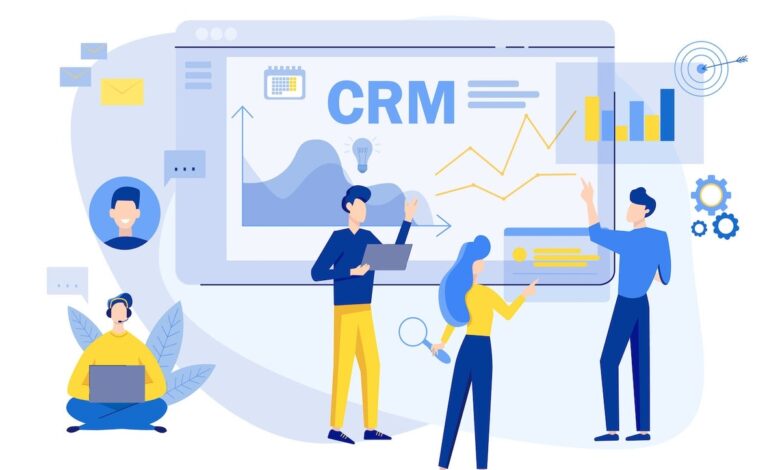
A powerful customer relationship management tool can go a long way toward generating leads, managing customer dataand empowering your marketing and sales efforts. We recommend HubSpot for sales teams looking for an all-in-one CRM with robust email marketing features and free AI tools. If you want an alternative with advanced reporting and analytics for your larger sales team, Salesforce is a better fit for you.
HubSpot vs. Salesforce: Comparison table
| Feature | Salesforce | HubSpot |
|---|---|---|
| Contact and management | Yes | Yes |
| Email marketing | Yes | Yes |
| Customer support tools | Yes | Yes |
| Reporting and analytics | Yes | Yes |
| Workflows and automations | Yes | Yes |
| Artificial intelligence (AI) tools | Yes | Yes |
| Integrations | 4,000+ | 1,000+ |
| Mobile app | Yes | Yes |
| Free plan | No | Yes (5 users) |
| Starting price for paid tiers* | $25 per user per month | $15 per user per month |
| Visit Salesforce | Visit HubSpot |
*Pricing is based on annual subscriptions.
Hubspot vs. Salesforce: Pricing
HubSpot CRM pricing*
- Free Tools: No cost for various marketing, sales, service, content management systems and operations tools (for five users).
- Starter: $15 per user per month.
- Professional: $90 per user per month.
- Enterprise: $150 per user per month.
*Pricing is based on annual subscriptions.
Salesforce CRM pricing*
- Starter Suite: $25 per user per month.
- Professional:$80 per user per month.
- Enterprise:$165 per user per month.
- Unlimited:$330 per user per month.
- Einstein 1 Sales: $500 per user per month.
*Pricing is based on annual subscriptions.
SEE: Find out how Salesforce compares with Microsoft Dynamics.
HubSpot vs. Salesforce: Feature comparison
Contact and lead management
Winner: HubSpot
Both platforms have robust features for contact, lead and deal management. Salesforce Sales Cloud offers excellent customization options for contact data and tools for monitoring deal probability.
HubSpot, however, wins in this category because of its dynamic lead capture and management tool, which automatically inputs captured leads into its database for follow up. It also has an intelligent active lists feature that automatically updates to show which contacts might be ready to make a purchase soon.
Email marketing
Winner: HubSpot
Salesforce Marketing Cloud lets you send an impressive 5,000 email marketing messages per day across all plans. It also has a robust set of email templates that you can use to design professional-looking emails.
Meanwhile, HubSpot Marketing Hub offers extensive email marketing features and a user-friendly drag-and-drop email designer. It takes the competition to the next level by providing these features for free and adding A/B testing to its Professional tier.
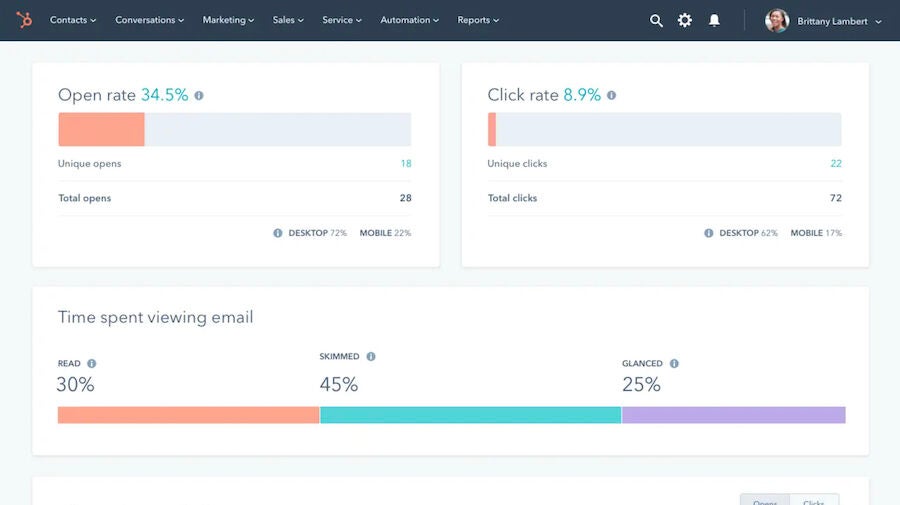
Customer support tools
Winner: HubSpot
Salesforce Service Cloud provides service reps with shared workspaces for collaboration, case management and ticket management. It automatically matches any form of customer communication to the best rep based on their skill level.
But HubSpot Service Hub, despite its fewer features, wins here because it makes it easier to onboard new customers, track tickets and engage with regular customers. Its free tier allows you to use a live chat widget, conversational bots, a shared inbox and reporting dashboards. Higher tiers give you access to contact scoring, feedback surveys and conversation intelligence.
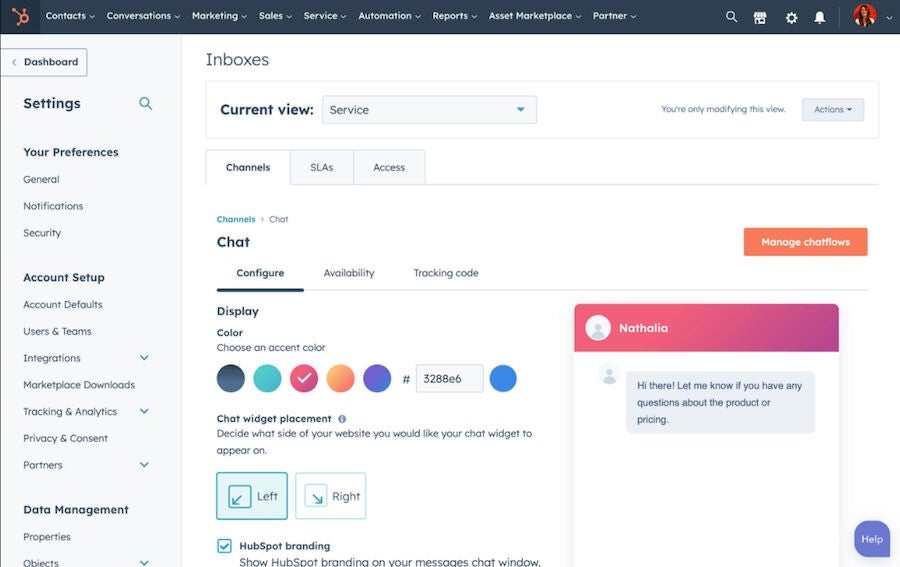
Reporting and analytics
Winner: Salesforce
Comparing the two services, we can see that both have highly advanced tools for sales reporting, forecasting and trends analysis. With HubSpot, you can easily build sales forecasts and attribution reports to help you optimize your marketing campaigns. You can also access detailed website traffic and sales analytics, so you can identify and fix problems in the customer journey.
With Salesforce, you can customize visual dashboards for easier monitoring of your team’s key metrics. Aside from that, its Einstein AI tool predicts deal closures, performs sentiment analysis, provides live data analytics and gives smart suggestions for performance improvement. All these give it an advantage over HubSpot in reporting and analytics.
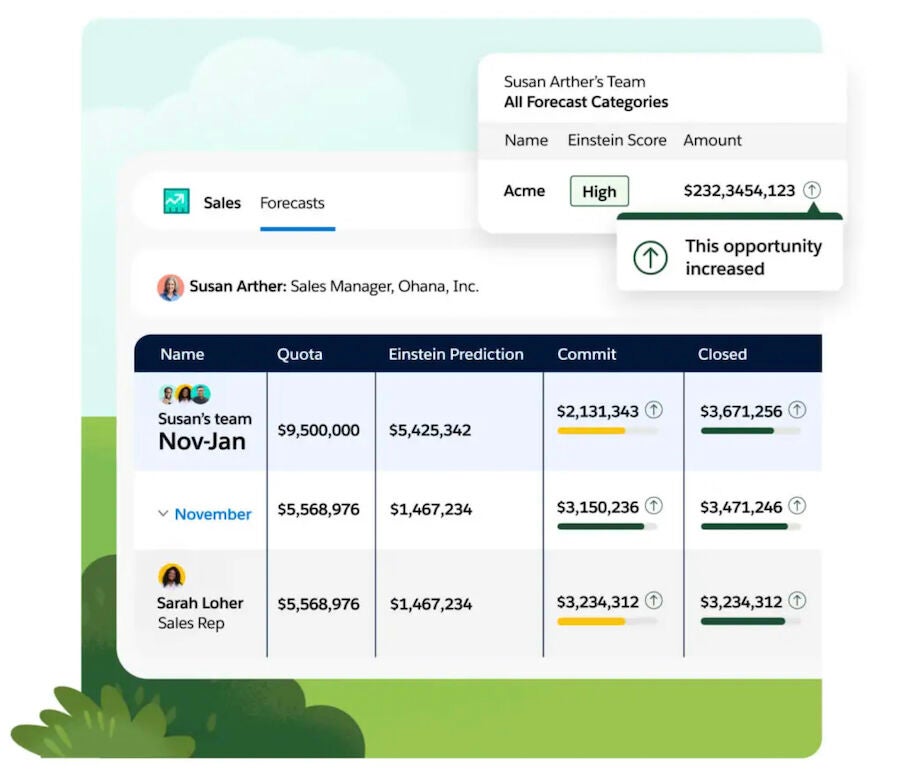
Workflows and automations
Winner: Salesforce
HubSpot offers a wide range of flexibility and a no-code process for building custom workflows. It lets you create revenue-based automations, such as the automatic assignment of a lead score based on your chosen attributes.
However, HubSpot does not have the more advanced automation capabilities that Salesforce has. These include action-triggered automations and an AI-integrated Flow Builder that gives you smart suggestions on more efficient workflows based on how you use Salesforce.
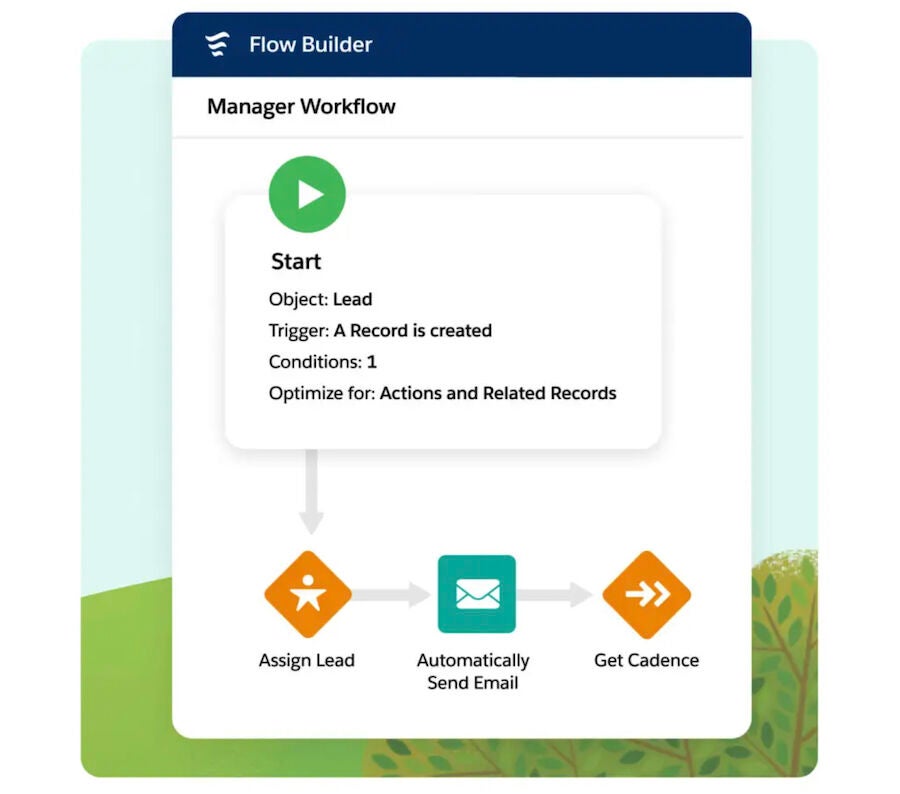
Artificial intelligence (AI) tools
Winner: HubSpot
Both Salesforce and HubSpot have some of the best-integrated AI tools for content generation, workflow automation, smart suggestions and predictive analytics. For Salesforce, its Einstein AI tool comes with tier-based features as a separate add-on. Its functions include text generation, sales forecasting, chatbot builder and workflow automation.
But HubSpot gets the winning spot because of its well-integrated AI features across all plans, including the free and lower-priced tiers. It has a built-in generative AI tool that generates original marketing copies, optimizes human-written text, suggests workflow enhancements and provides data-based insights. Plus, it is easier to use and customize compared to Salesforce’s Einstein AI.

Integrations
Winner: Salesforce
Salesforce wins in integrations, as it provides users with access to over 4,000 app integrations on its AppExchange marketplace. You can also look for integrations according to your industry and use case and build customized integrations for your CRM. HubSpot, on the other hand, has more than 1,000 integration options on its App Marketplace, with a focus on sales and marketing apps.
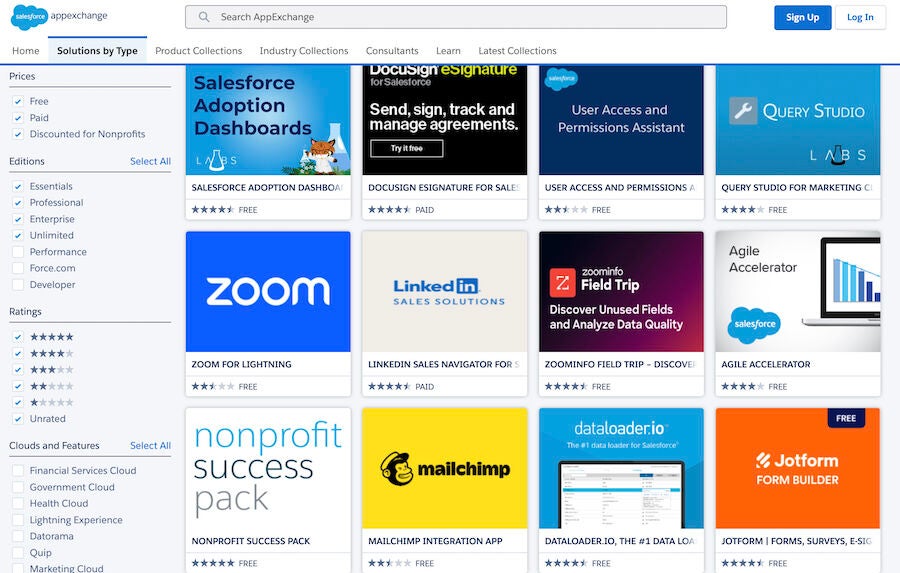
Mobile app
Winner: Salesforce
HubSpot’s mobile app allows users to manage leads, engage with contacts and track deals. It also offers a very clean and user-friendly interface design. In comparison, Salesforce’s mobile app also has an intuitive design but a complex navigation process. Nevertheless, it offers more functionalities that include CRM customization, call logging and document editing.
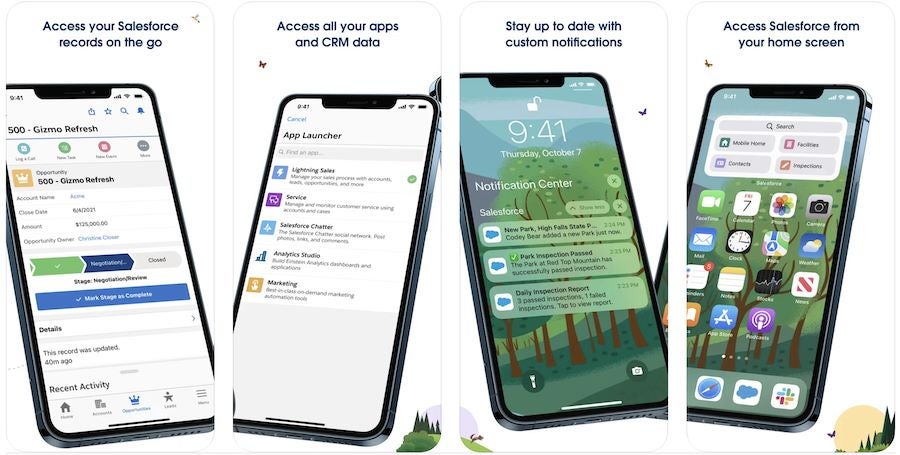
HubSpot pros and cons
The most recent HubSpot reviews reveal that the majority of its users find it to be a highly efficient tool for managing their sales processes, tasks and deals. They also like its simple interface, which makes it easy for them to learn and navigate. While most are satisfied with this CRM, there are some who wish for more in-depth reporting and analytics features.
SEE: Find out how HubSpot stacks up against Pipedrive.
Pros
- User-friendly platform.
- Extensive blog to help educate customers.
- All-in-one CRM tool.
- Core software is free.
- Real-time notification of lead behaviors.
- Personalized email sequences for both leads and existing customers.
- Highly customizable.
- Huge library of templates.
Cons
- Limited to one email per contact.
- Charges a graded premium beyond certain numbers of leads.
- Customer support is an add-on.
Salesforce pros and cons
Compared to HubSpot, Salesforce’s interface is less intuitive and has a steep learning curve. Nevertheless, its pop-up tips and recommendations walk users through navigating the platform. The biggest downside to this provider is the lack of a free option and the expensive plans. Still, the majority of its users like its excellent lead management tools, AI-powered analytics and sales process automations.
SEE: For more information, check out our full Salesforce review.
Pros
- Add and remove features as needed.
- Nearly all sales reps understand the platform.
- Highly customizable dashboards.
- Bult-in social media functionality.
- Plenty of integrations.
- Salesforce Database helps organize and digitize company sales records.
- Allows for integration with any data source.
- Supports security standards and controls.
- Highly scalable.
Cons
- Expensive.
- Configuration is complex.
- Steep learning curve throughout.
- Generating reports can be tricky.
- Costly data storage.
Choosing between HubSpot and Salesforce
Both options can get expensive, especially at scale and when added features are needed. The difference between HubSpot and Salesforce use cases, however, is size. If you’re a large enterprise company, Salesforce is, by far, the best option. Not only is the feature set massive, but you’d be hard-pressed to find a sales or marketing employee who doesn’t know the platform.
On the other hand, HubSpot is a great option for small and midsize businesses and startups that need the power of CRM software but aren’t ready to dole out the cash for the costlier and more complicated Salesforce. Although HubSpot cannot stand up to the features found in Salesforce, it is certainly a worthy solution to help empower your sales and marketing departments to take your business to the next level.
Review methodology
To compare HubSpot vs. Salesforce, we evaluated these two CRMs based on several criteria. These include pricing and the availability of a free plan, free trial or demo, and billing options. We also looked at their core and niche CRM features, like lead and deal management, reporting, analytics, automations and AI tools. In addition, we considered the quality and cost of the software’s customer support.
Our references for these details include the providers’ online resources, demo videos and blogs. Aside from that, whenever possible, we sign up for free trials to get a personal feel for their interface. We also supplement this information with actual user ratings from reputable review sites like G2, Capterra, Play Store and App Store.



